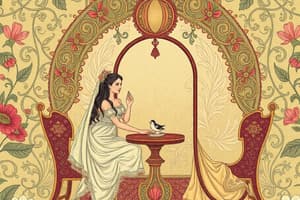Podcast
Questions and Answers
What does the term 'value' refer to in the context of color?
What does the term 'value' refer to in the context of color?
- The total number of colors used
- The saturation of a color
- The relationship between light and dark areas (correct)
- The brightness of a color
In which context is space considered an 'illusion'?
In which context is space considered an 'illusion'?
- Textiles and fabrics
- Graphic arts (correct)
- 3D modeling
- Sculpture and architecture
How is 'tone' related to value in color theory?
How is 'tone' related to value in color theory?
- Tone is the same as hue in color theory.
- Tone is another term for value. (correct)
- Tone refers only to the brightness of a color.
- Tone does not affect the value.
Which of the following aspects is NOT considered part of value in color theory?
Which of the following aspects is NOT considered part of value in color theory?
Which statement best describes the role of value in a painting?
Which statement best describes the role of value in a painting?
Which method can be used to create the illusion of depth?
Which method can be used to create the illusion of depth?
What are the qualities of sound in music as mentioned?
What are the qualities of sound in music as mentioned?
Which of the following is NOT considered an element of music?
Which of the following is NOT considered an element of music?
What does positive space refer to in a two-dimensional design?
What does positive space refer to in a two-dimensional design?
Which characteristic is associated with sound in music?
Which characteristic is associated with sound in music?
Which of the following elements of visual art refers to the feel or tactile quality of the surface of an object?
Which of the following elements of visual art refers to the feel or tactile quality of the surface of an object?
Which principle of visual art defines the arrangement of elements to create stability or imbalance?
Which principle of visual art defines the arrangement of elements to create stability or imbalance?
What is the primary use of the element of shape in visual art?
What is the primary use of the element of shape in visual art?
Which of the following is NOT an element of visual art?
Which of the following is NOT an element of visual art?
Which of the following describes the principle of emphasis in visual art?
Which of the following describes the principle of emphasis in visual art?
How does texture function in visual art?
How does texture function in visual art?
In discussing visual arts, how are elements of art generally used?
In discussing visual arts, how are elements of art generally used?
Which element is often associated with creating depth in a visual artwork?
Which element is often associated with creating depth in a visual artwork?
Flashcards are hidden until you start studying
Study Notes
The Medium of Architecture
- Encompasses various disciplines, including interior design and landscaping.
- Architecture combines aesthetics and functionality, impacting how spaces are utilized and perceived.
The Elements and Organization of Art
-
Visual Arts
- Focus on essential components and principles of visual art.
-
Elements of Visual Art
- Line: Defines shapes and contours, guiding viewer's attention.
- Shape: Two-dimensional area defined by boundaries; can be geometric or organic.
- Texture: Refers to the tactile quality of a surface; includes smooth, rough, furry, or silky.
- Function: Adds depth and interest to artwork.
- Color: Encompasses physical properties and emotional effects; influences mood and perception.
- Value: Refers to the tonal relationship between light and dark; essential for creating contrast and depth.
- Value and tone create dimensions in visual narratives.
- Space: Both an illusion in graphic arts and a tangible element in sculpture and architecture.
- Techniques like layering and perspective enhance the illusion of depth.
-
Principles of Visual Art
- Organize the various elements to create harmonious compositions.
Sound and Music
-
Sound Qualities
- Four general qualities of sound encompass tone and noise, essential in music composition.
-
Elements of Music
- Fundamental components like rhythm, melody, harmony, and dynamics interact to create musical pieces.
Visual Representations
- Visual aids, such as diagrams and images, enhance comprehension of concepts, illustrating principles like positive and negative space.
- Positive space refers to the areas occupied by subjects in art, while negative space refers to the areas around and between objects.
Studying That Suits You
Use AI to generate personalized quizzes and flashcards to suit your learning preferences.




